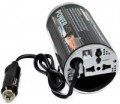Rated power output
The total power supplied by the autoinverter in normal operation. In other words, this parameter can be described as the
highest rated power of the connected load, at which the device is able to work without failures and overloads for a long time (comparable to the discharge time of the battery used for power).
Accordingly, when choosing according to the rated output power, it is worth proceeding from the energy consumption of the intended load. At the same time, it is worth choosing an inverter with a margin of 15-20% — for example, for a laptop with a consumption of 150 W, a device with at least 175 W is recommended. This is due not only to overload protection, but also to the fact that many inverters are able to deliver the claimed power only when the battery is fully charged, and as this charge is exhausted, it decreases.
It is also worth considering that some devices, such as car refrigerators or household vacuum cleaners, consume significantly more energy when starting up than during normal operation. Therefore, when choosing an inverter for such devices, it is worth focus not only on the rated, but also on the peak power — the power that the auto-inverter is capable of delivering without consequences within a few seconds.
Peak power output
The highest total power supply (peak) that the autoinverter can deliver to the load for a relatively short time is 2-3 s. Usually, this power is higher than the nominal one (see above) by 30-50%. At the same time, if you choose an inverter for maximum power, the same rules apply as for the nominal one — the device performance should be 15-20% higher than the total power of the connected load. And to work with devices that consume a large amount of energy at startup (vacuum cleaners, power tools, etc.), it is also worth specifying the peak power of the inverter — it should not be lower than the "starting" load power.
Output waveform
The shape of the graph of the voltage produced by the autoinverter.
-
Pure sine. The classic alternating voltage graph has this form - incl. and what is present in 230 V household networks. Thus, a sine wave indicates a high quality of the output signal - the voltage changes evenly, without sudden changes and as close as possible to the parameters of conventional sockets. This allows you to connect almost any load to the autoinverter - even audio systems and other delicate electronics that are sensitive to power quality. On the other hand, such quality requires the use of complex control circuits and has a noticeable impact on cost, but there is a real need for it not so often. Therefore, a sinusoidal signal is typical mainly for premium autoinverters.
—
Modified sine. This term (also called “approximate”) means that this output signal shape is only approximately similar to a sine wave. As a rule, such a graph looks like “steps”, sometimes quite large. This is enough to power most types of load used in cars - from lamps and power tools to televisions and laptops; At the same time, the autoinverters themselves are not as expensive as models with a pure sine wave. Their disadvantage is the inability to work with sensitive electronic devices, but this point cannot be called critical: the list of such devices is quite small, and they are used very rarely in cars.
Protection
Protection systems provided in the design of the autoinverter.
—
Against short circuit. A short circuit occurs due to a sharp drop in load resistance to very small values (for example, due to insulation breakdown or circuit contamination in a device connected to an autoinverter). As a result, the current increases critically, which can lead to damage to both the load and the inverter itself, and even fire and injury. This protection prevents such consequences by turning off the power in the event of a short circuit.
—
From overheating. Protection against critical temperature increase of the autoinverter: when heated, the system turns off the device, preventing damage and other undesirable consequences. Note that overheating is not necessarily a sign of a problem — it can also occur during prolonged operation in normal mode (which does not negate the need to turn it off to avoid trouble).
—
From overload. Overloads occur when the power consumption of the connected device(s) exceeds the output power of the auto inverter (see above). Such situations lead to work in emergency modes, which is fraught with breakdowns and even fires. Some of the consequences of such situations can be handled by other protection systems (for example, the overheating protection described above), but in this case it is easier to prevent the cause than to deal with th
...e consequences.
— From incorrect connection. A system that protects the auto-inverter from connecting with the wrong polarity: detecting a mismatch between “plus” and “minus”, the protection turns off the device, preventing breakdowns and other troubles. This function is found only in models connected directly to the battery (see above) — it is impossible to reverse the polarity when plugged into the cigarette lighter socket.Dimensions
General dimensions of the autoinverter.
In modern cars (especially passenger cars), usually, there is not much space for installing additional equipment. This parameter allows you to estimate the space required to place the inverter, make sure that the selected device fits into the “footprint”, and, if necessary, choose another location or another model. At the same time, it must be remembered that for many auto-inverters a certain margin is needed in place — for the normal operation of the cooling system; this margin is usually specified in the detailed documentation.
